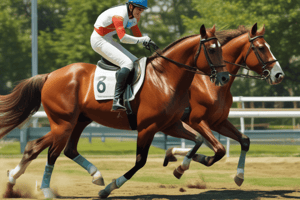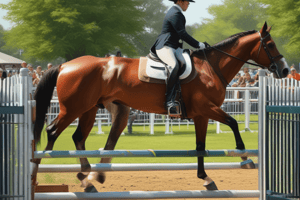Podcast
Questions and Answers
Which of the following is true regarding equestrian portraits?
Which of the following is true regarding equestrian portraits?
- They are used exclusively for royal figures.
- They do not include any animals.
- They convey the subject's supreme power and leadership. (correct)
- They are only painted in modern times.
Emanuel Leutze's Washington Crossing the Delaware describes the historic event when __________________
Emanuel Leutze's Washington Crossing the Delaware describes the historic event when __________________
General Washington led his troops across the Delaware River to fight in the Battle of Trenton.
In the painting by Antoine-Jean Gros, what message was the artist trying to spread?
In the painting by Antoine-Jean Gros, what message was the artist trying to spread?
He intended to show Napoleon as a Christ-like figure, healing the sick with his touch.
This is a portrait of Henry VIII. Which of the following is not a true statement about this portrait?
This is a portrait of Henry VIII. Which of the following is not a true statement about this portrait?
Which of the following pieces of art would be considered a form of social protest?
Which of the following pieces of art would be considered a form of social protest?
Which of the following is a true statement about the portrait of Philip IV?
Which of the following is a true statement about the portrait of Philip IV?
________________ is an influence or authority over other people, territories, or nations.
________________ is an influence or authority over other people, territories, or nations.
What did Picasso intend to show through his painting Guernica?
What did Picasso intend to show through his painting Guernica?
Which artist painted the piece entitled Guernica?
Which artist painted the piece entitled Guernica?
Propaganda is ________________
Propaganda is ________________
Flashcards
Equestrian portraits
Equestrian portraits
They convey the subject's supreme power and leadership.
Washington Crossing the Delaware depicts
Washington Crossing the Delaware depicts
General Washington led his troops across the Delaware River to fight in the Battle of Trenton.
Message of Antoine-Jean Gros' painting
Message of Antoine-Jean Gros' painting
He wanted to show Napoleon as a Christ-like figure, healing the sick with his touch.
Not true about portrait of Henry VIII
Not true about portrait of Henry VIII
Signup and view all the flashcards
Social protest art
Social protest art
Signup and view all the flashcards
Portrait of Philip IV
Portrait of Philip IV
Signup and view all the flashcards
Political power
Political power
Signup and view all the flashcards
Picasso's intention with Guernica
Picasso's intention with Guernica
Signup and view all the flashcards
Guernica's artist
Guernica's artist
Signup and view all the flashcards
Propaganda is
Propaganda is
Signup and view all the flashcards
Study Notes
Political Purposes of Art
- Equestrian portraits symbolize supreme power and leadership through the depiction of a horse beneath a political figure.
- Emanuel Leutze's painting illustrates General Washington's historic crossing of the Delaware River during the Battle of Trenton.
- Antoine-Jean Gros aimed to depict Napoleon as a Christ-like figure, emphasizing themes of healing and leadership.
- The portrait of Henry VIII was designed to highlight his superiority and power, with an emphasis on the accuracy of his features for public perception.
- Pablo Picasso's "Guernica" serves as a significant example of social protest art, addressing the impact of war.
- The portrait of Philip IV was painted on horseback to downplay any imperfections, presenting a more powerful image.
- Political power refers to an individual or entity's influence or control over others, territories, or nations.
- "Guernica" portrays the suffering caused by the Nazi bombing during the Spanish Civil War, underscoring the brutality of war and the evils of Fascism.
- Pablo Picasso is the artist behind the impactful piece "Guernica."
- Propaganda is defined as content created with the intention to influence people's thoughts, opinions, or actions intentionally.
Studying That Suits You
Use AI to generate personalized quizzes and flashcards to suit your learning preferences.




